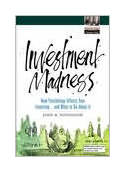|
||
• wydawnictwa polskie
• Zamów informacje o nowościach z wybranego tematu • kontakt
• Cookies na stronie |
INVESTMENT MADNESS. HOW PSYCHOLOGY AFFECTS YPUR INVESTING.NOFSINGER J.wydawnictwo: PRENTICE HALL , rok wydania 2001, wydaniecena netto: Table of Contents 1. Your Behavior Matters! I. NOT THINKING CLEARLY. 2. Overconfidence. 3. Overconfidence and
Investing. III. EMOTIONS RULE. 5. Seeking Pride and
Avoiding Regret. 6. Double or Nothing. III. FUNCTIONING OF THE BRAIN. 8. Mental Accounting. 9. Mental Accounting and
Diversification. IV. INVESTING AND THE INTERNET. 12. The Internet (Psycho)
Investor. 13. Exuberance on (and
about) the Net. V. WHAT CAN I DO ABOUT IT? 14. Self-Control, or the Lack
of It! 15. Battling Your Biases. Preface IntroductionWe are all prone to having psychological preconceptions or biases that make us behave in certain ways. These biases influence how we assimilate the information we come in contact with on a daily basis. They also have an impact on how we utilize that information to make decisions. Some of the decisions that are influenced by our psychological biases can have a large impact on our personal wealth - or the lack of it. I have written this book to try to show you how your own psychological biases can creep into your investment decisions and sabotage your attempts at building wealth. WHAT TO EXPECT FROM THIS BOOK There are five parts in this book. The first three parts illustrate different psychological biases that affect our daily lives. The chapters in these parts are structured so they are similar to each other. First, I identify the psychological trait and explain using common, daily activities. Then I examine the degree to which investors are affected by the bias. Part 4 demonstrates how the Internet exacerbates these psychological problems. Finally, the chapters in Part 5 describe what investors can do to help themselves. The chapters in Part 1, "Not Thinking Clearly," demonstrate how investment decision making is not always rational. As you will see, people set their range of possible outcomes too narrowly. This is part of a broader problem called overconfidence. Overconfident investors trade too much, take too much risk, and earn lower returns. This topic is discussed in Chapter 2 and 3. If overconfidence causes investors to act too frequently, other biases described in Chapter 4 causes investors to fail to act when they should. Part 2, "Emotions Rule," shows how the emotions associated with investing affect our decisions. Chapter 5 illustrates how an investor's view of himself causes him to avoid feelings of regret and to seek pride. Consequently, investors sell winner stocks too soon and hold onto loser stocks too long. Chapter 6 demonstrates that your past failures and successes have a dramatic impact on your current decision making process. Lastly, our emotional state is often affected by the social aspects of investing; we discuss this in Chapter 7. The third part, "Functioning of the Brain," shows how the human brain's processes for interpreting and remembering information affect investors. For example, every day you are bombarded by information. The brain uses a process called mental accounting to store and keep track of important decisions and outcomes. Chapter 8 shows that as a consequence of this process, people make poor financial decisions. Discussed in Chapter 9 is one particularly important implication of how investors view portfolio diversification. The brain also uses shortcuts to quickly process information. This leads to impacts on investor memory (Chapter 10) and the problem of representativeness and familiarity (Chapter 11). Part 4, "Investing and the Internet," discusses the interaction among the Internet, psychology, and investing. The Internet allows investors quick access to information, trading, and other investors' opinions. However, these attributes actually magnify the psychological biases. These issues are addressed in Chapters 12 and 13. Finally, part 5, "What Can I Do About It?" discusses what the investor can do to avoid these psychological biases. The difficulty of maintaining self-control in the face of the psychological biases is illustrated in Chapter 14. The last chapter shows that planning, incentives, and rules of thumb are helpful in avoiding the common problems. 192 pages
Po otrzymaniu zamówienia poinformujemy, |


